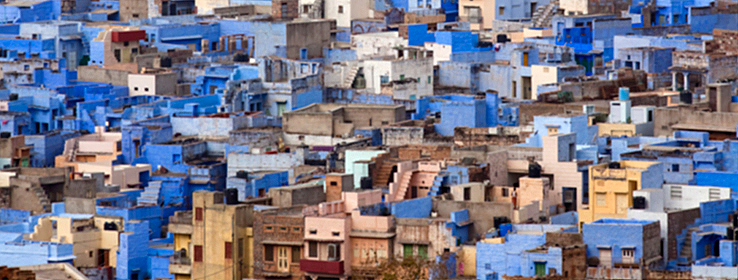Kim Palmer
We used Sherwin-Williams Chip It!™ to grab this palette from the image above of Jodhpur.
Jodhpur, India’s ancient “Blue City,” has long captivated visitors with its colorful mystery.
The world is full of places named or nicknamed for colors. And in many such places, there are few visible cues to explain why.
But Jodhpur, India’s “Blue City,” fully lives up to its moniker. Visitors seeing the ancient city for the first time are enchanted by its blue-on-blue vistas - buildings of azure and aqua, cobalt and cornflower - arrayed below and around its towering medieval fort like a collar of gemstones.
Set in the middle of the Rajasthan state, one of the oldest human civilizations on the planet, in the desolate Thar Desert, Jodhpur’s distinctive blue cityscape must have looked like a mystically cool oasis to weary travelers.
Entering the old city, with its narrow streets and alleys, and being surrounded by block after block of blue is even more striking. Many of the buildings are set off by vibrant pink doors or lime-green shutters, which heightens the magical effect.
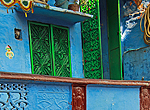
Legend and lore
Why are so many houses in Jodhpur painted blue? The tradition has been maintained for so many centuries that no one knows for sure. But there are several theories.
According to one legend, a former king wanted to impress some visiting dignitaries. After weighing ideas with members of his court, he finally decided that all the houses viewed from the fortress should be made blue, to create a dazzling, indelible panorama.
Others speculate that the city’s arid desert location left its inhabitants with such a powerful thirst for color that they painted their dwellings blue, the hue associated with water, as a refreshing antidote to the parched brown around them.
Some locals today insist that blue helps keep interiors cool and mosquitos out, although if this were true, there would likely be a lot more blue cities in other hot, buggy places.
The most widely accepted theory is that Jodhpur’s blue dwellings are a colorful remnant of India’s caste system. Under this theory, the Brahmins, the highest class, made up of priests and scholars, had their homes painted blue to differentiate themselves from members of other castes. At some point, lower castes started appropriating the tradition, until virtually the whole city was painted blue.
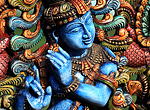
A lordly hue
How did blue, of all colors, come to be associated with India’s elite? Color as a whole and individual hues have deep symbolic meaning in Indian culture and the Hindu religion. Hindus believe that color enhances mood and well-being, and that its proper use keeps people happy and cheerful.
Hindu artists also use color when representing the deities, to symbolize their essential qualities. The color blue is associated with Lord Krishna, one of the most favored gods in India, who devoted himself to protecting his people and destroying evil. Krishna is often depicted wearing blue and even with blue skin, to symbolize his determination, strong character and ability to master challenging situations.
Blue is the bravest and manliest of all colors, according to Hindu tradition, so it’s not surprising that India’s highest-status individuals - and eventually everyone - would appropriate that hue, cloaking themselves and their homes in an aura of respect and admiration.
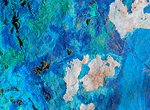
The color of money
Blue may be associated with courage, bravery and other virtues in the Hindu faith tradition - but it’s also associated with cold, hard cash. In early times, blue became a status symbol because it was one of the most difficult and expensive hues to reproduce.
The first blue pigment, made from the mineral azurite, was known as “Egyptian blue.” However, during the Middle Ages, around the time Jodhpur was founded as a city, the recipe for producing Egyptian blue was lost, according to the online exhibit Pigments Through the Ages. Costly ultramarine from Afghanistan became the primary source for creating the color. Thus blue pigments and dyes were rare and expensive, and the color was associated with wealth and privilege.
By the 15th century, artisans were starting to produce blue paint using finely ground blue glass. Later, chemically-produced blues were introduced: Prussian blue, followed by cobalt and cerulean. Blue eventually became accessible to the masses, but its aristocratic aura persisted.
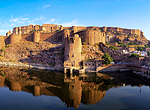
A majestic fortress
The centerpiece of Jodhpur’s buildings is the Mehrangarh Fort or “Citadel of the Sun,” a massive red sandstone edifice that looms 400 feet above the skyline. Rudyard Kipling called it “the work of giants,” and during a 1984 visit, Jacqueline Kennedy Onassis said: “I have just seen the eighth wonder of the world.”
Built and expanded over a period of five centuries, from the 1400s to the 1950s, it reflects a wide range of architectural styles and periods. Now a museum, the fort’s galleries display such exotic wonders as silver howdahs (seats for riding on elephants) and palanquins (litters for carrying royalty and aristocrats); daggers with gold and silver inlays; and a rainbow of textiles, including carpets, embroideries and brocades.
The fort also houses several stunning period rooms, including the Hall of Mirrors royal bedchamber; the 18th century gilded Palace of Flowers reception room; and the Palace of Pearls, its walls covered with lime plaster mixed with crushed shells to create a pearlescent luster.
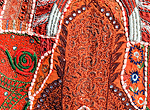
Living kaleidoscope
While visitors to Jodhpur are first entranced with its brilliant blueness, a closer look reveals the city to be a kaleidoscope of vivid colors. The men of Jodhpur favor bright-red or pink turbans, while women wear vibrant saris and veils in hot pink, saffron, lime, magenta, aqua and brilliant tangerine.
Jodhpur resides in the ancestral home of the Marwari people, known for their business acumen, and many of the city’s buildings boast gold-trimmed embellishments and furnishings with richly colored fabrics, reflecting the grandeur of its pre-Colonial wealth when it was a trade center for copper, opium and silks.
At the Sardar Market, the old city bazaar near the fort, intricate patterns and rich, saturated colors appear in everything from footwear to bangles to textiles, often in combinations that dazzle Western eyes.




